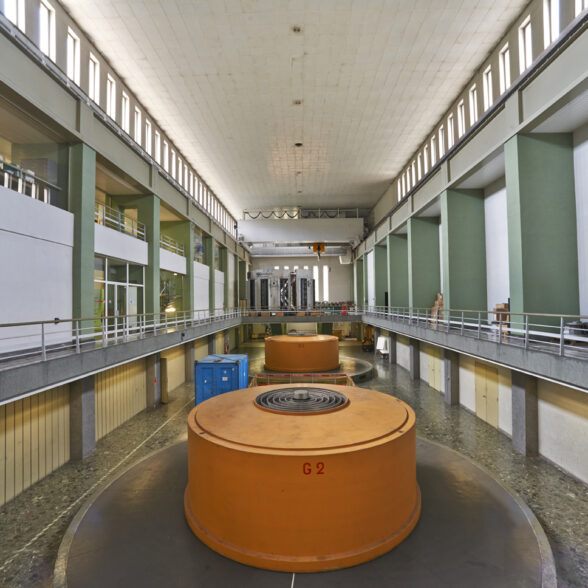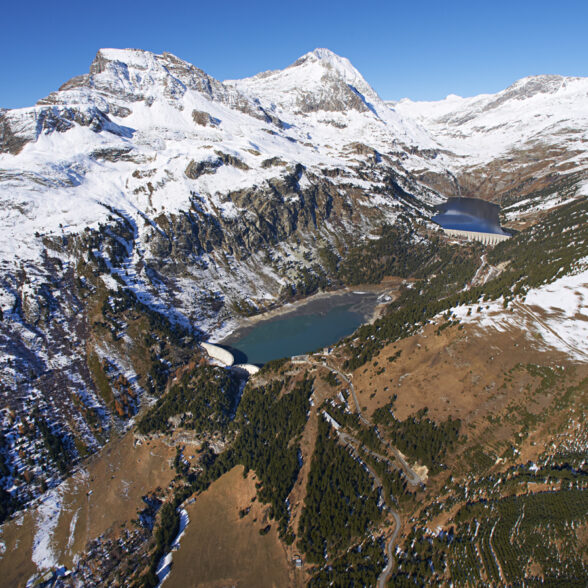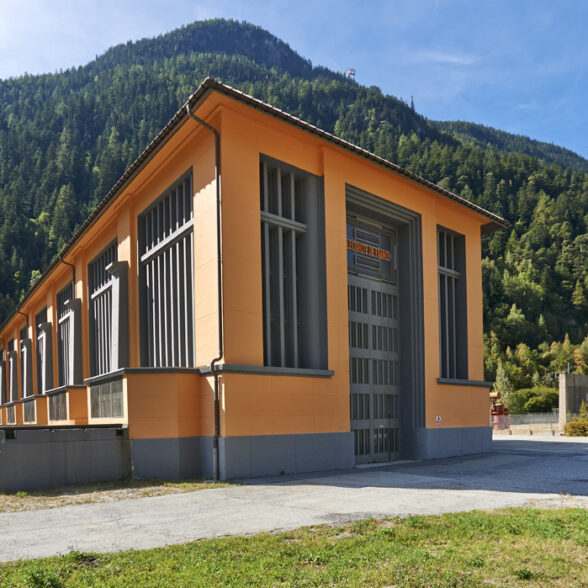Hydropower: the energy produced in Haute Maurienne
Since the early 20th century, the Mont-Cenis plateau, whose waters flow naturally towards Italy, had been developed for hydroelectric production. After the Second World War, following the Peace Treaty of 1947, the border that passed through the Col du Mont-Cenis was shifted in favor of France, which thus recovered the entire plateau, an ideal position for building a large-scale dam. The new dam, built by EDF between 1962 and 1969, created a reservoir with a capacity of 320 hm3, shared between the two countries at the rate of around 1/5 for Italy and 4/5 for France.
At 120 m high and 1.4 km long, the Mont-Cenis dam is the main component of the Haute Maurienne Vanoise hydraulic system. It is a so-called "gravity dam", meaning that its enormous mass of rock opposes the pressure of the water. To fill it, water is drawn from sources such as Bonneval sur Arc. The reservoir is even connected to the Plan d'Aval dam in Aussois, on the other side of the valley! A complex system of tunnels and penstocks transfers water from one reservoir to another, supplying the Villarodin, Avrieux and Aussois power stations as required.
The Mont-Cenis site has been the focus of a program of works designed to improve the landscape and preserve an international heritage, including the rehabilitation of the Grand-Croix mountain pasture, the undergrounding of power lines and the creation of a Franco-Italian network of hiking trails. Some of the water from this development is also used to produce artificial snow for several ski resorts on Haute Maurienne Vanoise.


The Mont Cenis dam is the last in France to be guarded, due to its location on the border between France and Italy. The dam operators, one French and one Italian, spend several days on site, surveying the kilometers of tunnels that criss-cross the mountain, taking readings and checking the quality of the installations.

At the end of the 1930s, Société Hydroélectrique de Savoie (SHES) wanted to create the Plan d'Amont and Plan d'Aval reservoirs above Aussois to improve production at its electrometallurgical plants in the valley. Work began in 1939, was interrupted by the Second World War and then resumed by EDF at the end of the conflict. For the anecdote, or for film buffs, the site was used as a set for the film "La Meilleure Part" starring Gérard Philippe.
Above the Plan d'Aval dam, the platform of the old cable car used for the construction work has been converted into a lookout point. Panels provide information about the dams and power plants, as well as the landscape and environment. Since 2016, it has also been possible to cross the Plan d'Aval dam, in particular for a 2-hour walk around the reservoir (for cycling enthusiasts, there's also a superb cross-country course). Here you can discover a stunning black sand beach and, season permitting, sample some of the wild raspberries that grow along the path.
Built as part of the Mont Cenis development project, the Villarodin power plant at the foot of La Norma is unique in that it is fed by water from 2 structures: the Plan d'Aval reservoir on the Aussois side and the Mont Cenis dam on the Val Cenis side. When it was commissioned in 1968, the Villarodin power station held the world power record, with 180,000 kW generated by each of its 2 Pelton turbines. Designed to supply electricity during peak demand periods, the plant can start up in a matter of minutes and rapidly feed power into the French grid.
Thanks to its architecture and history, the Villarodin power plant is part of the Les Chemins de l'hydroélectricité cultural discovery itinerary: accompanied by Fondation Facim guide-lecturers, you can visit the power plant in summer and discover its links with the development of the region, from its construction to the present day.
The Aussois power plant in Savoie was commissioned in 1950. The power station is equipped with 3 Pelton turbines. It turbines water from the Plan d'Aval reservoir via a metal penstock. This penstock feeds either the Aussois hydroelectric plant or the wind tunnel at the ONERA center in Modane-Avrieux, located next door (aerodynamic test wind tunnel of the Office National d'Études et de Recherches Aérospatiales). A fine example of the coexistence on the same site of
hydroelectricity and hydromechanics
The Avrieux power station is the oldest in the Haute Maurienne Vanoise hydroelectric group. Construction began in 1917, but was not completed until 1923. It is fed by the Bramans dam. With its distinctive architecture and impressive engine room, it is open to visitors in summer (registration required).

The Haute Maurienne Vanoise dams supply 10 hydroelectric power stations: Bissorte, Super-Bissorte, Orelle, Villarodin, Combe d'Avrieux, Aussois, Avrieux, Plan d'Amont, Le Carrelet, Bois d'Aussois.
On average, these developments produce the equivalent of 2 times the annual residential consumption of the Savoie department.
At the entrance to Haute Maurienne Vanoise, the Bissorte and Super-Bissorte power plants, located in the communes of Le Freney and Orelle, turbinate water from two reservoirs: the Bissorte dam at altitude, and the Pont des Chèvres dam along the road.
Commissioned in 1986, the Super-Bissorte power plant is one of France's six Stations de Transfert d'Énergie par Pompage (STEP), whose principle is to transfer the same water between two reservoirs separated by a steep gradient. This system enables the water to be reused, as if in a closed circuit. During periods of high electricity demand (morning, day and evening), water from the high-altitude dam (Bissorte dam) flows down to the power plant via a penstock. Powered by the water, the turbines generate energy. But rather than being returned directly to the river, the water is stored again in the lower reservoir (Pont des Chèvres dam). At night, when electricity demand is low, the water is pumped back up to the Bissorte dam. The next day, the circuit can start again...
Super-Bissorte is a generation facility of national interest, capable of injecting around 800 MW (Bissorte and Super-Bissorte combined) into the power grid in a matter of minutes to meet a peak in electricity consumption.
